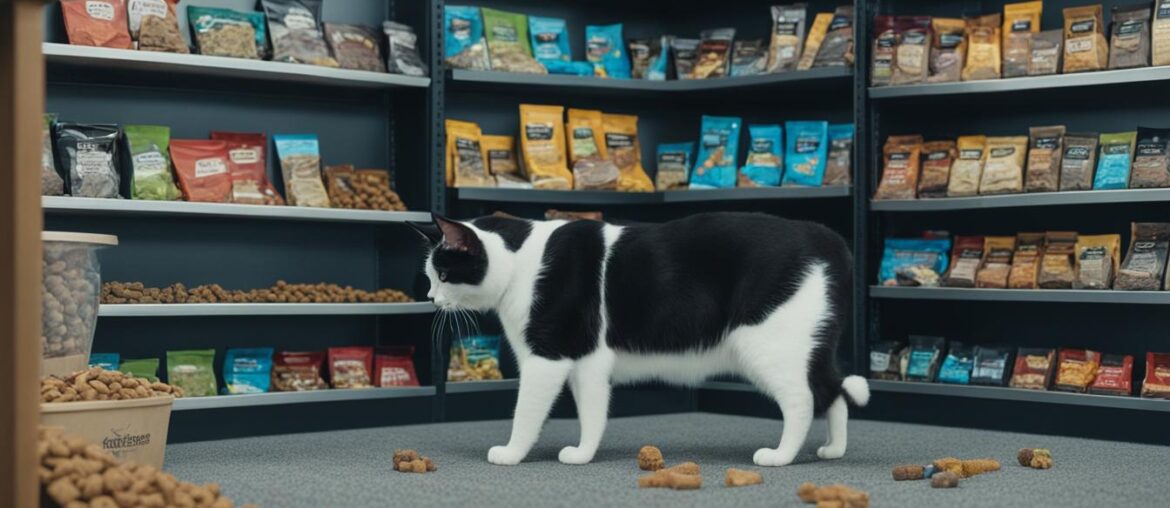When it comes to our beloved pets, their health and nutrition are of utmost importance. As cat owners, it’s natural to wonder if our feline friends can partake in the same treats as their canine counterparts. Can cats eat dog treats? Let’s dive into the topic and explore expert insights on cat nutrition and diet.
Key Takeaways:
- Cats have different dietary requirements than dogs, making it important to consider their specific nutritional needs.
- Cat treats are formulated to meet the unique dietary requirements of cats, including higher levels of meat-based protein.
- Feeding cats dog treats regularly can lead to potential health issues due to the imbalance of nutrients in their diet.
- Consulting with a veterinarian is crucial in determining the best treat options for your cat’s overall health and well-being.
- Choose treats specifically formulated for cats to ensure they receive the necessary nutrients in their diet.
Can Dogs Eat Cat Treats?
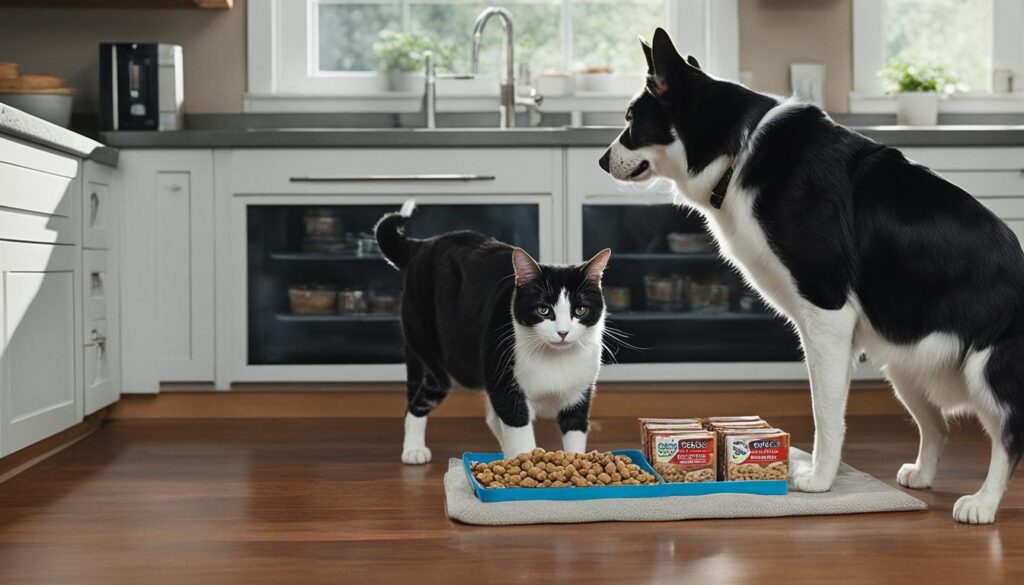
While dogs can technically eat cat treats, it is not recommended for them to have them regularly as a part of their diet. Cat treats are specifically formulated to meet the nutritional needs of cats, which differ from those of dogs. Dogs have their own dietary requirements that should be met with treats specifically made for them.
Feeding dogs cat treats on a regular basis can lead to an imbalance in their diet, as these treats might not provide the necessary nutrients for their overall health and wellbeing. It is important to prioritize treats that are specially designed to meet the nutritional needs of dogs and provide the right balance of protein, carbohydrates, and other essential nutrients.
Dogs and cats have different digestive systems, and what may be safe and suitable for one species may not be as beneficial for the other. Cat treats, for example, are often higher in protein and lower in carbohydrates compared to dog treats, which reflect the dietary needs of cats as obligate carnivores.
Therefore, it is best to stick to dog treats that are specifically tailored to meet the nutritional needs of dogs. These treats are formulated to provide the right balance of nutrients and are often available in a variety of flavors and textures to suit different preferences and dietary requirements.
Comparison of Dog Treats and Cat Treats
| Aspect | Dog Treats | Cat Treats |
|---|---|---|
| Protein Content | Varies, balanced mix | Higher, meat-based |
| Carbohydrate Content | Varies, balanced mix | Lower |
| Texture | Dense, hard, chewy | Soft, smooth |
| Flavor | Varies, meat and non-meat options | Varies, meat options |
As shown in the table above, dog treats and cat treats differ in their nutritional content, texture, and flavor profiles. Choosing treats that are specifically made for dogs will ensure that they receive the appropriate nutrients and enjoy treats that cater to their taste preferences.
“Feeding dogs cat treats regularly can lead to an imbalance in their diet and may not provide all the necessary nutrients they need.”
Ultimately, it is important to prioritize the health and well-being of our furry friends by providing them with treats that are tailored to their individual dietary needs. Always consult with a veterinarian for specific dietary recommendations and guidance on selecting the most appropriate treats for your dog.
Risks of Dogs Eating Cat Treats
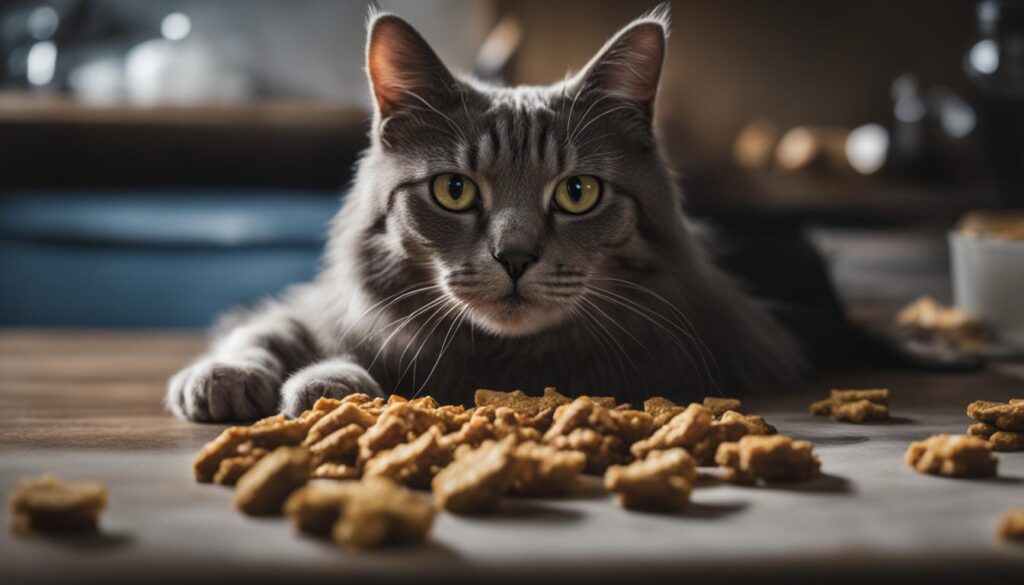
Feeding dogs cat treats regularly can lead to potential health risks. Cat treats usually have higher calories, which can contribute to weight gain and obesity in dogs. The high protein and fat content can also cause digestive issues such as stomach cramps and intestinal discomfort. Some dogs may also be sensitive or allergic to certain ingredients in cat treats, leading to skin irritation and other allergic reactions.
To summarize, here are the potential health risks of dogs consuming cat treats:
- Weight Gain and Obesity: Cat treats are often higher in calories, contributing to weight gain and potential obesity in dogs.
- Digestive Issues: The high protein and fat content in cat treats can lead to stomach cramps and intestinal discomfort in dogs.
- Allergic Reactions: Certain ingredients in cat treats may cause skin irritation and other allergic reactions in dogs.
Comparison of Cat Treats and Dog Treats
| Treats | Calories | Protein Content | Fat Content | Carbohydrate Content |
|---|---|---|---|---|
| Cat Treats | High | Varies, often higher | Varies, often higher | Lower |
| Dog Treats | Varies | Varies | Varies | Varies |
This table provides a comparison between the nutritional content of cat treats and dog treats. As you can see, cat treats tend to have higher calories, protein, and fat content, while dog treats can vary in their nutritional composition.
It is important to prioritize your dog’s specific dietary needs and provide treats that are formulated for their well-being. Consult with a veterinarian for guidance on selecting the right treats for your dog’s diet.
Can Cats Eat Dog Treats?
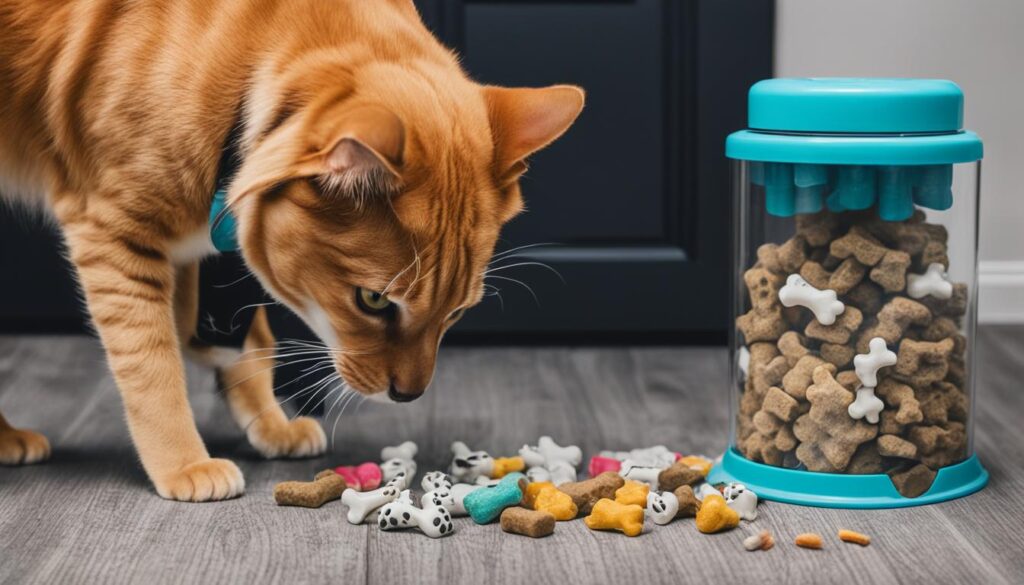
Cats and dogs may seem like similar animals, but when it comes to their dietary needs, they have distinct differences. Cats are obligate carnivores, which means they require high levels of meat-based protein for their overall health and well-being. On the other hand, dogs are omnivores and have more flexible dietary requirements.
While dogs can eat a variety of different foods, including plant-based ingredients, cats rely heavily on animal-based protein sources for essential nutrients. So, can cats eat dog treats? The answer is yes, but it should be done with caution.
Cat nutrition is crucial in maintaining their health and ensuring they receive all the necessary nutrients they need. Feeding cat-specific treats that are formulated to meet their dietary requirements is always recommended. However, if you find yourself in a situation where your cat accidentally consumes a dog treat, it is unlikely to cause any harm. But it is important to avoid feeding them dog treats regularly as a part of their diet.
The Nutritional Imbalance
Cats and dogs have different nutritional requirements, and dog treats are not formulated to meet the specific needs of cats. Dog treats often contain a mixture of ingredients, including grains, vegetables, and meat. While these treats may seem delicious to your cat, they may not provide the necessary balance of nutrients that cats require.
Cats need essential amino acids like arginine and taurine, which are usually found in higher quantities in animal-based proteins. These amino acids are vital for their health and the proper functioning of their bodies. Many dog treats do not contain adequate levels of these essential amino acids, which can lead to nutritional deficiencies if fed to cats regularly.
Additionally, some dog treats may have higher levels of carbohydrates and lower levels of protein compared to what cats need. Cats have a limited ability to digest carbohydrates, and a high-carbohydrate diet can lead to weight gain and other health issues.
Feeding dog treats to cats regularly can disrupt the balance of nutrients in their diet and potentially lead to health problems such as nutrient deficiencies, weight gain, and digestive issues.
Ensuring a Balanced Diet for Your Cat
Providing your cat with a well-balanced and nutritionally complete diet is essential for their overall health and well-being. Cats thrive on high-quality, species-appropriate cat food that contains the necessary nutrients they require.
When it comes to treats, it is best to choose cat-specific treats that are formulated with the nutritional needs of cats in mind. These treats are designed to provide the right balance of nutrients and are a safer choice for your feline friend. Consult with your veterinarian to find the best treats for your cat and to ensure they are getting all the nutrients they need.
Difference Between Dog Treats and Cat Treats
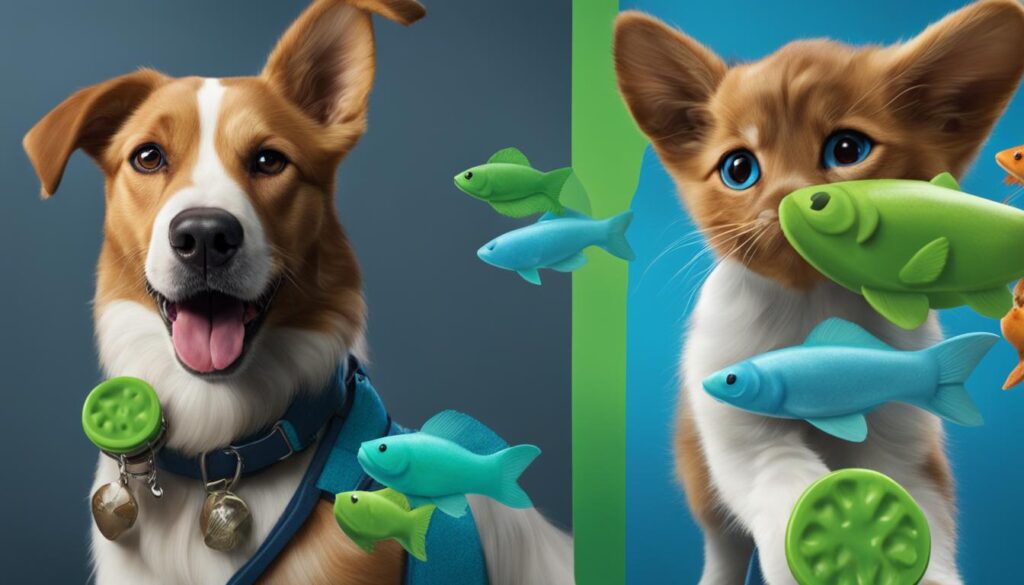
When it comes to treats, dogs and cats have specific dietary requirements that differ from each other. Dog treats and cat treats may appear similar at first glance, but they vary in size, ingredients, texture, and nutritional content.
Let’s take a closer look at the differences between dog treats and cat treats:
- Size: Dog treats are often larger in size compared to cat treats, as dogs have bigger mouths and jaws.
- Ingredients: Cat treats are formulated with higher levels of meat-based protein and fewer carbohydrates, catering to their obligate carnivore nature. Dog treats, on the other hand, typically contain a more balanced mix of protein, fat, and carbohydrates.
- Texture: Cat treats are usually soft and smooth in texture, making them easier for cats to chew and digest. Dog treats can vary in texture, ranging from dense and hard to chewy.
- Nutritional Content: Cat treats focus on providing high levels of meat-based protein to meet the specific dietary needs of cats. They usually contain fewer fillers and carbohydrates. Dog treats, on the other hand, aim for a more balanced nutritional profile, incorporating a mix of protein, fat, and carbohydrates.
Understanding the differences between dog treats and cat treats is crucial in ensuring that your pets receive the appropriate nutrition. While dogs can occasionally enjoy cat treats, it is important to provide treats specifically formulated for each species to meet their unique nutritional requirements.
Now that we’ve explored the distinctions between dog treats and cat treats, it’s essential to choose treats that align with your pets’ specific needs to promote their overall health and well-being.
| Cat Treats | Dog Treats | |
|---|---|---|
| Size | Smaller | Larger |
| Ingredients | High levels of meat-based protein, fewer carbohydrates | More balanced mix of protein, fat, and carbohydrates |
| Texture | Soft and smooth | Dense, hard, or chewy |
| Nutritional Content | High meat-based protein, fewer carbohydrates | Balanced mix of protein, fat, and carbohydrates |
Treats That are Suitable for Both Cats and Dogs
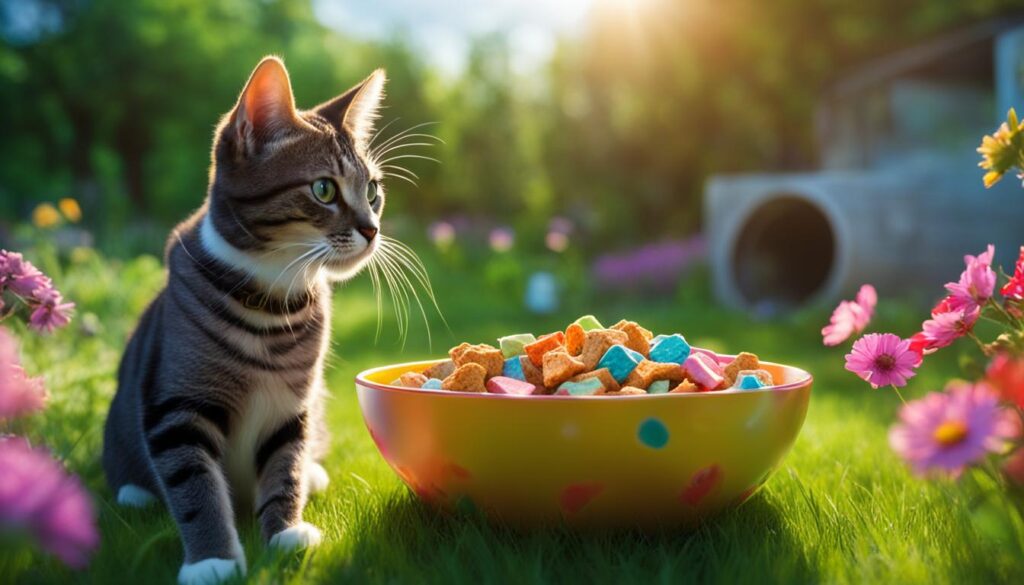
When it comes to treating our beloved pets, we want to ensure that they receive the best. While cats and dogs have different nutritional needs, there are some treats that can be enjoyed by both species. These shared treats are formulated with ingredients that are safe and beneficial for both cats and dogs, making them a convenient option for multi-pet households.
Shared treats are designed to cater to the specific dietary requirements of both cats and dogs. They contain a balanced mix of ingredients that provide essential nutrients and flavors that appeal to both species. These treats are typically soft and easy to chew, ensuring that they are suitable for pets of all ages and sizes.
When choosing shared treats for your pets, look for products that are specifically labeled as suitable for both cats and dogs. This ensures that the treats meet the necessary standards for both species and are safe for consumption. It’s always a good idea to consult with your veterinarian to determine the appropriate treats for your pets based on their individual needs and health conditions.
“Shared treats provide a convenient and hassle-free option for pet owners with both cats and dogs. They offer a way to bond with our pets and reward them without having to purchase separate treats for each species.” – Dr. Emily Johnson, Veterinarian
Feeding shared treats to your pets can be a great way to reinforce positive behavior, train them, or simply show your love. However, it’s important to remember that treats should be given in moderation and not replace a balanced diet. It’s also crucial to monitor your pets while they are enjoying their treats to ensure they don’t swallow them whole or experience any choking hazards.
Now, let’s take a closer look at some popular treats that are suitable for both cats and dogs:
1. Freeze-Dried Chicken Treats
| Treat | Description |
|---|---|
| Freeze-Dried Chicken Treats | A single ingredient treat made from high-quality chicken meat that is freeze-dried to preserve its flavor and nutrients. Suitable for both cats and dogs, these treats are rich in protein and low in fat. |
| Tuna Flakes | Tasty and nutritious, tuna flakes are a hit with both cats and dogs. They are made from real tuna and provide a good source of protein. These treats can be served as a reward or sprinkled over their meals. |
| Salmon Sticks | Salmon sticks are a delicious and healthy treat option for both cats and dogs. Made from real salmon, these treats are packed with omega-3 fatty acids that support skin and coat health. |
These treats are just a few examples of the shared options available for cat and dog owners. Remember to always read the labels, check for allergens, and introduce new treats gradually to avoid any digestive upsets for your pets. By choosing treats that are suitable for both cats and dogs, you can ensure that your furry friends can indulge in their favorite snacks together, strengthening the bond between them and promoting their overall well-being.
Why Does My Dog Love Cat Treats?
Dogs are often irresistibly attracted to cat treats, and there are a few reasons behind this canine curiosity. One main factor is the higher meat-based protein content found in cat treats. Dogs, being omnivores, instinctively crave the taste of meat, and cat treats offer a concentrated dose of animal protein that can be highly enticing to them.
Additionally, the stronger smell and flavor of cat treats, derived from ingredients like salmon and tuna, can make them more appealing to dogs. Dogs have a keen sense of smell, and the aroma of these fish-based treats can be particularly alluring to our canine companions.
However, it is important to remember that cat treats are specifically formulated to meet the nutritional needs of cats. Although dogs may enjoy the taste of these treats, they may not provide all the necessary nutrients that dogs require for optimal health. Feeding dog treats formulated for dogs is the best way to ensure they receive the nutrients their bodies need to thrive.
Why Do Some Dogs Prefer Cat Treats?
There are a few reasons why some dogs may prefer cat treats over their own. Firstly, cats have a more discerning palate and are often more selective eaters than dogs. This means that cat treats need to be especially appealing to entice cats to eat them. The stronger flavors and aromas in cat treats can make them more tempting for dogs as well.
| Reasons Why Dogs Love Cat Treats |
|---|
| Cat treats have higher meat-based protein content |
| Stronger smell and flavor |
| Cats are more selective eaters, making cat treats more appealing in taste |
However, it’s important to monitor the amount of cat treats your dog consumes, as dog treats are specifically formulated to meet their dietary needs. Too many cat treats could lead to an imbalance of nutrients in your dog’s diet, potentially causing health issues over time.
Safe Treats for Dogs and Cats

When it comes to pet treats, it’s essential to choose options that are safe for both dogs and cats. While their dietary needs may differ, there are treats available that cater to both species without compromising their health. One notable brand that offers a diverse range of such treats is Freeze Dry Australia.
Freeze Dry Australia specializes in freeze-dried pet treats made from high-quality ingredients. Their range includes freeze-dried sardines and chicken breast, which are not only delicious but also meet the dietary requirements of both cats and dogs. These treats are carefully prepared to retain their natural flavors and nutrients, providing a nutritious and flavorful snacking option for your pets.
What sets Freeze Dry Australia’s treats apart is their commitment to pet nutrition. The brand understands the importance of providing pets with balanced and nutrient-rich treats that contribute to their overall well-being. By prioritizing pet nutrition, Freeze Dry Australia ensures that their treats are safe and beneficial for both dogs and cats.
Whether you have one pet or multiple furry friends, finding treats suitable for all can simplify your shopping experience and promote harmony in your household. Freeze Dry Australia’s treats offer versatility, allowing you to provide your pets with a shared snacking experience while addressing their individual nutritional needs.
Here are some key reasons why Freeze Dry Australia’s treats are a safe choice for both dogs and cats:
- Safe and suitable ingredients for both species
- Cater to the dietary requirements of dogs and cats
- Retain natural flavors and nutrients through freeze-drying
- Promote pet nutrition and overall well-being
By opting for treats like those offered by Freeze Dry Australia, you can ensure that your pets receive safe and nutritious snacks that they’ll love. Treat time can be a bonding experience for you and your furry companions, and with these shared treats, you can indulge them while keeping their health in mind.
The Rise of Functional Pet Treats
Pet owners are increasingly interested in treats that offer health or functional benefits for their pets. The demand for functional pet treats, which have specific health-related claims, has been on the rise. These treats are formulated to promote various aspects of pet health, such as immune system health, dental care, joint support, and more.
This growing trend can be attributed to the increasing awareness among pet owners about the importance of overall pet wellness. Pet owners want treats that not only taste good but also provide added value to their pets’ health and well-being.
Functional pet treats are among the fastest-growing new product launches in the pet treat category. With advancements in pet nutrition research and the development of specialized ingredients, pet treat manufacturers are able to create innovative formulations that offer specific health benefits.
One of the key benefits of functional pet treats is that they allow pet owners to address specific health concerns or promote wellness in a convenient and enjoyable way. Instead of relying solely on pet food, these treats offer an additional avenue to address specific health issues or supplement pet diets.
For example, functional pet treats may contain ingredients such as glucosamine and chondroitin for joint support, probiotics for digestive health, or antioxidants for immune system support. These treats provide an easy and delicious way for pet owners to incorporate these beneficial ingredients into their pets’ daily routine.
“Functional pet treats provide pet owners with the opportunity to actively contribute to their pets’ overall health and wellness.”
| Benefits of Functional Pet Treats |
|---|
| Promote immune system health |
| Support joint health |
| Improve dental care |
| Aid in digestion |
| Support skin and coat health |
Functional pet treats not only provide health benefits but also serve as a form of positive reinforcement during training or bonding activities with pets. They can be used to reward good behavior, engage in interactive play, or simply show love and affection to our furry companions.
As pet owners become more conscious of the impact of nutrition on their pets’ health, the popularity of functional pet treats will likely continue to grow. Manufacturers are constantly innovating to create new and exciting formulations that cater to various health needs and preferences.
When choosing functional pet treats, it is important to consider your pet’s specific needs and consult with a veterinarian if necessary. Each pet is unique, and their dietary requirements may vary based on factors such as age, breed, and existing health conditions.
By incorporating functional pet treats into your pet’s diet, you can provide them with a delicious and nutritious way to support their overall health and wellness.
Pet Treat Sales Growth
Pet treats have been experiencing significant sales growth worldwide. In the US, pet treats are one of the fastest-growing segments in pet specialty stores, with dog treat sales growing nearly 10% a year. In Western Europe, dog treat sales have increased about 5% annually, while cat treat sales have risen even more at 8.6%. The rising demand for healthier and functional pet treats has contributed to this growth.
| Region | Dog Treat Sales Growth | Cat Treat Sales Growth |
|---|---|---|
| US | 10% per year | N/A |
| Western Europe | 5% per year | 8.6% per year |
Preventing Dogs from Eating Cat Treats
Dogs can be notorious for their curious nature and tendency to eat anything in sight, including cat treats. However, it is important to prevent dogs from consuming cat treats to avoid potential health risks or digestive issues.
Storing Treats Separately
One of the most effective ways to prevent dogs from eating cat treats is to store them separately. Keep cat treats in a secure location that is inaccessible to dogs, such as a high shelf or a closed cabinet. This will help avoid any accidental ingestion by a curious dog.
Supervising Pets While Eating
When feeding your pets, it is essential to supervise them to ensure they are eating their own treats and not each other’s. By closely monitoring their feeding sessions, you can quickly intervene if a dog attempts to snatch a cat treat or vice versa.
Training Dogs to Leave Cat Treats
Training your dog to leave cat treats alone can be beneficial in preventing them from consuming these treats. Teach your dog the “leave it” or “drop it” command and reinforce it consistently. With time and practice, your dog will learn to resist the temptation of cat treats.
Feeding Pets Separately
To minimize the opportunity for dogs to access cat treats, it is advisable to feed your pets separately. Establish designated feeding areas for both your cat and dog, ensuring they are adequately distanced from each other. This prevents accidental sharing of treats and eliminates the possibility of a dog consuming cat treats.
Using Pet Gates or Barriers
If you have a multi-pet household, utilizing pet gates or barriers can be an effective way to segregate your pets during treat time. These physical barriers provide a clear divide between your cat and dog, ensuring that each pet can enjoy their treats without interference.
By implementing these measures, you can create a safe and controlled environment for your pets, preventing dogs from eating cat treats. Prioritizing pet treat separation promotes their overall health and wellbeing.
| Preventing Dogs from Eating Cat Treats | Benefits |
|---|---|
| Storing Treats Separately | – Avoid accidental ingestion – Keep treats secure |
| Supervising Pets While Eating | – Ensure pets eat their own treats – Prevent treat theft |
| Training Dogs to Leave Cat Treats | – Teach commands like “leave it” or “drop it” – Promote self-control in dogs |
| Feeding Pets Separately | – Establish designated feeding areas – Eliminate treat sharing |
| Using Pet Gates or Barriers | – Create physical divide between pets – Ensure treat enjoyment without interference |
Creating a safe environment and reinforcing pet treat separation are essential for maintaining the health and well-being of your pets. By following these guidelines, you can prevent dogs from eating cat treats and promote harmony in your multi-pet household.
Wrapping Up
When it comes to pet treats, it’s important to prioritize the specific dietary needs of your pets. While dogs can technically eat cat treats and vice versa, it is best to stick to treats that are specifically formulated for each species. Cat treats are designed to meet the nutritional requirements of cats, while dog treats are formulated for dogs.
Choosing the right treats for your pets is crucial in ensuring their health and well-being. Cats are obligate carnivores and require high levels of meat-based protein, while dogs have a more balanced mix of protein, fat, and carbohydrates in their diet. Feeding the wrong treats may lead to nutritional imbalances or potential health issues.
If you’re unsure about which treats to choose, it is always recommended to consult with a veterinarian. They can provide valuable advice on your pet’s specific dietary needs and help you select the appropriate treats for them. Your veterinarian can also guide you on portion sizes and frequency, ensuring that your pets receive the right amount of treats without compromising their overall diet.
In conclusion, pet treats play a role in keeping our furry friends happy and satisfied. By understanding the different nutritional requirements of cats and dogs and choosing treats that cater to their specific needs, we can provide them with delicious and nutritious rewards. Remember to prioritize your pet’s health and consult with a veterinarian to make informed choices about their diet and treat options.
FAQ
Can cats eat dog treats?
Cats can technically eat dog treats, but it should be done with caution due to their different nutritional requirements.
Can dogs eat cat treats?
While dogs can technically eat cat treats, it is not recommended for them to have them regularly as a part of their diet.
What are the risks of dogs eating cat treats?
Feeding dogs cat treats regularly can lead to potential health risks, including weight gain, digestive issues, and allergies.
What is the difference between dog treats and cat treats?
Dog treats and cat treats differ in terms of size, ingredients, texture, and nutritional content.
Are there treats that are suitable for both cats and dogs?
Yes, there are some treats that can be fed to both cats and dogs, which are formulated with safe and suitable ingredients for both species.
Why do dogs love cat treats?
Dogs may be drawn to cat treats because of their higher meat-based protein content and stronger smell and flavor.
What are safe treats for dogs and cats?
Safe treats for dogs and cats include those that are specifically formulated for each species and cater to their specific dietary needs.
What are functional pet treats?
Functional pet treats are treats that offer health or functional benefits for pets, such as promoting immune system health or improving dental care.
How is the pet treat market growing?
Pet treat sales are experiencing significant growth worldwide, with dog treat sales growing nearly 10% a year in the US.
How can I prevent dogs from eating cat treats?
Preventing dogs from eating cat treats involves measures such as storing treats separately, supervising pets while eating, and using pet gates or barriers.
Can cats eat dog treats?
Cats can technically eat dog treats, but it is important to consider their specific nutritional requirements and potential health issues.


